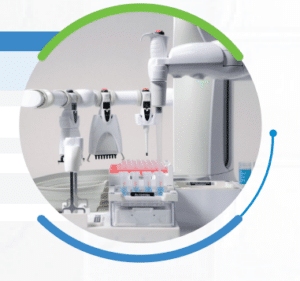Read Time: 5 min
Pipetting Robots – a quick brief:
- Pipetting robot offers fully automated liquid handling using electronic pipettes and labware holders called Dominos.
- Using a pipetting robot will allow you to transition from laborious manual pipetting procedures to error-free, fully-robotized lab workflows.
Ensuring precision within a lab environment is of key importance, especially when dealing with research samples. As laboratories advance technologically, the scope of discovery has been pushed to explore new areas.
The use of automated technology, like robotics, have transformed lab workflows. This move towards automation has meant that some lab procedures have been streamlined to allow for previously manual tasks such as pipetting to be moved to an automated system.
Pipetting: Why move from manual to automated?
Manual pipetting within a laboratory setting remains a crucial task, but traditional methods such as manual pipetting have historically been laden with errors. Issues such as fatigue, external variables and differing techniques have all led to accuracy challenges.
Next generation lab systems such as the Andrew+ pipetting robot from Andrew Alliance has eliminated the challenges associated with manual pipetting. Their technology ensures correct liquid handling every time, ensuring efficiency and reliability.
The Andrew+ Robot: The Top #5 Features
1. Versatility:
The Andrew+ pipetting robot system allows for various applications with its range of smart electronic pipettes. This means that the system is capable of handling large amounts of liquids and procedures simultaneously. The systems design allows for fast experiment setups and has many features that make the robot a perfect automation partner for any laboratory.
2. Efficient Design:
The system is not only efficient in terms of its capabilities but also in its compact design, this makes this system the partner needed for your laboratory automation without having to make changes to your lab space.
3. Simple Platform:
The Andrew+ robot is integrated with OneLab, an intuitive browser-based software that allows scientists to design and execute pipetting protocols. The simplicity and ease of these systems together make moving to an automated platform seamless.
4. Improved Productivity:
Improved productivity is a key feature of the platform, by automating your laboratory pipetting you are reducing the amount of lab errors through human error. This not only improves the reproducibility of experiments but also boosts overall laboratory productivity.
5. Health and Safety:
By moving away from a manual to an automated pipetting process, you will reduce the frequency and risk of musculoskeletal disorders in your staff, an automated system also allows for hazardous materials to be handled electronically by the robot, therefore mitigating risk to your staff.
What is the bigger picture when it comes to laboratory automation?
The move towards automation within labs has seen positive results across various industries. We have seen increased efficiency, improved timelines on research projects and improved productivity among staff.
The Top #3 ways automation will improve your laboratory research and development:
Data Quality: Improved data quality, leads to increased reliability and efficiency within your research findings.
Costings: Automation will minimize the frequency of having to perform experiments, which will in turn minimize the amount of waste produced by your laboratory and ultimately reduce labour and material costs.
Improved Timelines: Moving to an automated system means your researchers can allow for multiple experiments to run simultaneously and iterate on their hypotheses with greater speed.
What is the future of Laboratory Automation?
The world of technology continues to advance at an accelerated rate, we have seen big strides within the automation field and the advancement of pipetting robots will only continue to grow with time.
Future advancements could see enhanced integration with artificial intelligence for data analysis, greater connectivity between lab equipment, and further developments in the size of robotic components could all make a big difference.
With these improvements and advancements, we will see big boundaries being pushed and the scientific world moving towards greater discoveries.
The Andrew+ pipetting robot offers fully automated liquid handling using electronic pipettes and labware holders called Dominos. Andrew+ evolves into a full walk-away automation solution.
Creating the connected laboratory, Andrew+ is part of the OneLab ecosystem, executing laboratory protocols designed in OneLab. This flexible architecture enables you to effortlessly transition from laborious manual pipetting procedures to error-free, fully-robotized lab workflows – without any knowledge of programming, laboratory robotics or automation engineering.
By moving to the Andrew+ pipetting robot you will see increased flexibility and precision within your lab work. The system provides your researchers with the ability to expand on their research efforts and to advance within their science field of discovery.
Click below to Watch video
For more information about the Andrew+ pipetting robot, visit us here.
Find out more about Waters



